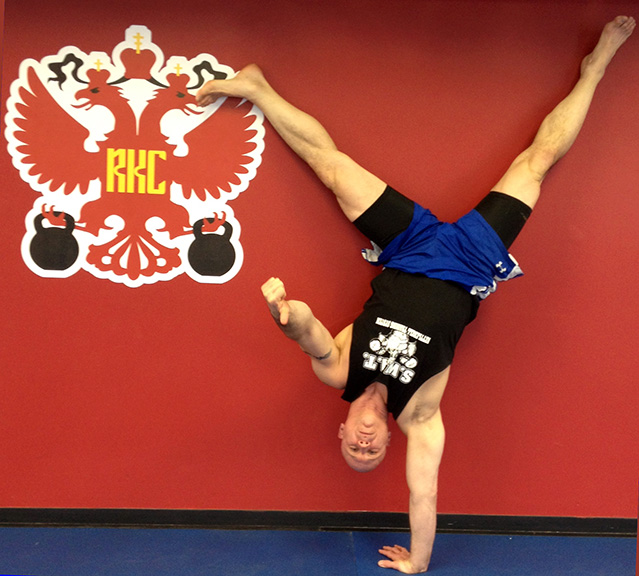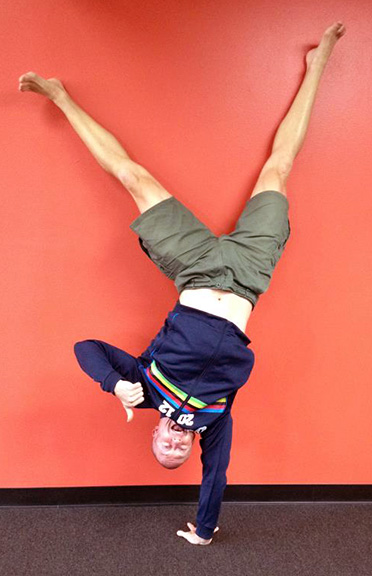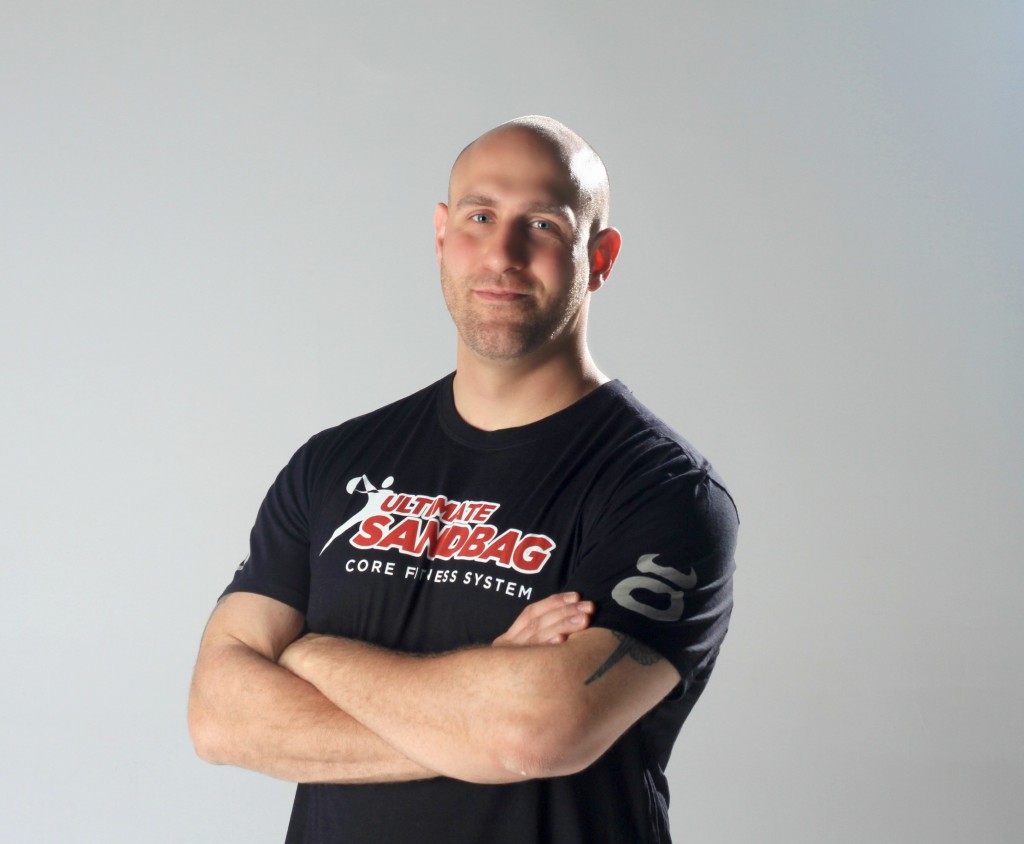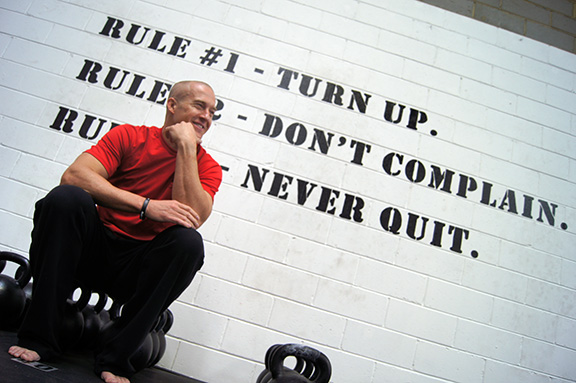 The Handstand, I LOVE IT! It’s such a fun exercise to do. I will tell you though, that it was very challenging for me to accomplish. I’m not a gymnast, I’m a 189 lb, 51 year old man who hadn’t done much inverted training since walking on my hands in college back in the ’80’s (and banging out 20 reps of Handstand Push-ups after wrestling practice). Throw in a few injuries, especially the most recent one in 2011 and the thought of me being upside-down and unsupported was an unlikely proposition. I then took the first ever PCC in June of 2013 and I was determined to be able to perform a Free Standing Handstand. During the PCC, I accomplished a few personal bests, but I was unable to hit the Free Standing Handstand for more than a few unbalanced seconds. I didn’t “own” the movement. So, I laid out a plan and executed it. I referenced the PCC manual, took the advice the Kavadlo Brothers had given me at the certification and some other tips from Max Shank, and I was off and “standing.”
The Handstand, I LOVE IT! It’s such a fun exercise to do. I will tell you though, that it was very challenging for me to accomplish. I’m not a gymnast, I’m a 189 lb, 51 year old man who hadn’t done much inverted training since walking on my hands in college back in the ’80’s (and banging out 20 reps of Handstand Push-ups after wrestling practice). Throw in a few injuries, especially the most recent one in 2011 and the thought of me being upside-down and unsupported was an unlikely proposition. I then took the first ever PCC in June of 2013 and I was determined to be able to perform a Free Standing Handstand. During the PCC, I accomplished a few personal bests, but I was unable to hit the Free Standing Handstand for more than a few unbalanced seconds. I didn’t “own” the movement. So, I laid out a plan and executed it. I referenced the PCC manual, took the advice the Kavadlo Brothers had given me at the certification and some other tips from Max Shank, and I was off and “standing.”
After about 2 months of dedicated training with the “Grease the Grove” method, I was able to hit a Handstand with relative ease and hold it. My best Handstand was a 29 second hold. I was even able to hit a few push-ups–3 was my best. Albeit, they are not full, touch my head to the ground push-ups, but I did break the 90 degree plane. I was even able to pull off a Handstand on top of two 24KG bells!
You may be asking yourself what is so great about the Handstand? For one, doing Handstands improves your pressing ability by reaffirming the proper alignment of your shoulders, neck arms, torso and legs. If you are not balanced, you will fall. If you have the proper alignment required for the Handstand, you’ll be conditioning your body to adopt the most efficient position for proper execution of the Kettlebell Press. Think about the alignment of your shoulder, arm, neck, torso, etc..for the Press and then look at the Handstand – IDENTICAL! Additionally, Free Standing Handstand and Wall Push-ups require and increase your strength dramatically without the use of weights! Imagine you are a 225 pound guy performing Handstand Push-ups, that’s a lot of beef being pushed around! Simply getting into the position and holding has incredible strength developing benefits.
Handstands are now part of my training regimen and I encourage all of my students to practice them as well. Even if a particular individual does not ever hit a perfect, Free Standing Handstand, SO WHAT? They are getting stronger and better conditioned throughout the process. Additionally, their pressing will get better, they will get stronger and their shoulders will be healthier. Plus, you never know; keep plugging away long enough and almost ANYTHING is possible. Please read on….
One of my female clients was a little reluctant to attempt the Handstand. She has four children and her shoulders needed strengthening. She was having issues with her core and her presses as well. She couldn’t even hold a Crow Stand for more than 3 seconds before taking a nose dive. Not a likely Handstand Candidate, right? WRONG! I first started her with the Crow Stand with several karate striking pads piled up to support her head while she developed the necessary tension to be able to hold herself up. Once she achieved 30 seconds, I’d remove a pad. By the end of the month, she was performing the Crow Stands–sans the pads!
We then moved to the wall. She had a fear of being inverted, so we needed to build her confidence with “Face the Wall” Handstands. After she got closer and closer and was able to hold the position for 30 seconds, I had her kick-up into the outward facing “Wall Handstand.” Using the 30 second time as an indicator to move to the next level, we began the “Free Standing Handstand” with me spotting her. This is where we are at four months later.
I really can’t tell you how long it will take another individual to progress, but she trains 3 to 4 days a week (sometimes 5) and she’s very motivated by health and strength. She is determined, dedicated and disciplined. Training is a priority. If you possess her attributes – There’s Nothing You Can’t Accomplish!
Coach Phil Ross
***
About Master RKC Phil Ross: Master RKC, 8th Degree Black Belt, Specialist in Bodyweight Strength, PCC and CK-FMS Certified. His name is synonymous with Martial Arts and Fitness. He is known as the area’s Kettlebell King and has successfully competed on the National Level in… Read more here.


